The Seismic Services Market is estimated to be valued at USD 9.1 billion in 2025 and is projected to reach USD 16.7 billion by 2035, registering a compound annual growth rate (CAGR) of 6.2% over the forecast period.
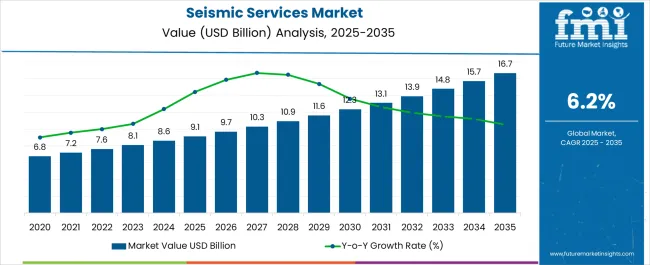
| Metric | Value |
|---|---|
| Seismic Services Market Estimated Value in (2025 E) | USD 9.1 billion |
| Seismic Services Market Forecast Value in (2035 F) | USD 16.7 billion |
| Forecast CAGR (2025 to 2035) | 6.2% |
The Seismic Services market is witnessing sustained growth, driven by the increasing demand for accurate subsurface imaging and exploration across the oil, gas, and energy sectors. The adoption of advanced seismic technologies is being supported by the need for efficient hydrocarbon exploration, resource management, and risk mitigation. Investments in exploration and production activities, coupled with the growing emphasis on optimizing extraction processes, are fueling demand for high-quality seismic services.
Continuous advancements in imaging techniques, data acquisition equipment, and processing algorithms have enhanced resolution, accuracy, and speed, enabling more reliable interpretation of subsurface structures. The integration of 3D and 4D seismic surveys, along with real-time data analytics and cloud-based storage, is providing greater operational efficiency and reducing costs.
Regulatory compliance, environmental considerations, and the push for sustainable exploration practices are further influencing market growth As exploration activities expand globally and energy companies increasingly rely on precise geological information, the Seismic Services market is expected to experience long-term growth driven by technological innovation and operational efficiency.
The seismic services market is segmented by type of data acquisition, services offered, technology, and geographic regions. By type of data acquisition, seismic services market is divided into Land Seismic Acquisition, Marine Seismic Acquisition, and Transition Zone Seismic Acquisition. In terms of services offered, seismic services market is classified into Data Acquisition, Data Interpretation, and Data Processing. Based on technology, seismic services market is segmented into 3D Imaging, 2D Imaging, and 4D Imaging. Regionally, the seismic services industry is classified into North America, Latin America, Western Europe, Eastern Europe, Balkan & Baltic Countries, Russia & Belarus, Central Asia, East Asia, South Asia & Pacific, and the Middle East & Africa.
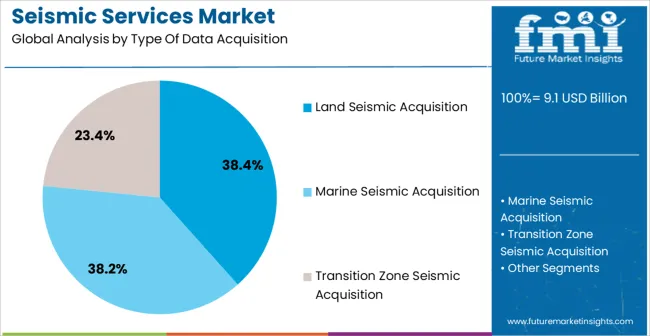
The land seismic acquisition segment is projected to hold 38.4% of the market revenue in 2025, making it the leading type of data acquisition. Growth in this segment is driven by its ability to provide high-resolution imaging of onshore geological formations, which is critical for hydrocarbon exploration and infrastructure development. Land seismic acquisition offers flexibility in survey design, precise data collection, and adaptability across varied terrains and geological conditions.
Advanced sensor arrays, positioning technologies, and real-time monitoring systems enhance data accuracy and reduce acquisition time. The ability to integrate acquired data with processing and interpretation workflows improves operational efficiency and supports informed decision-making.
Regulatory requirements, safety protocols, and environmental considerations are addressed through modern land acquisition methods, increasing adoption among energy companies As demand for accurate, reliable, and cost-efficient onshore exploration grows, the land seismic acquisition segment is expected to maintain its market leadership, supported by technological advancements and increased exploration investments.
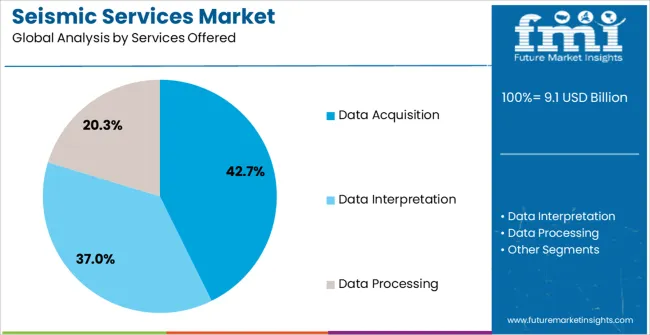
The data acquisition segment is anticipated to account for 42.7% of the market revenue in 2025, establishing it as the leading services category. Growth in this segment is driven by the increasing requirement for precise, high-quality subsurface data to support exploration and production activities. Data acquisition services encompass survey planning, sensor deployment, real-time monitoring, and quality control, enabling accurate imaging and interpretation of geological formations.
Advanced equipment and software solutions allow for efficient data collection, integration, and validation, reducing errors and improving reliability. Companies are leveraging these services to optimize exploration costs, enhance operational decision-making, and minimize environmental impact. Rising investments in oil and gas exploration, renewable energy projects, and geological surveys are further boosting demand for acquisition services.
The ability to deliver actionable insights quickly and integrate with downstream processing and analysis platforms reinforces the importance of this segment As energy companies seek efficiency, accuracy, and compliance, data acquisition services are expected to remain a primary driver of market growth.
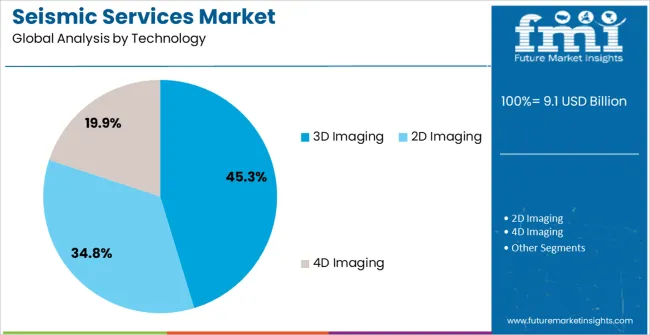
The 3D imaging technology segment is projected to hold 45.3% of the market revenue in 2025, establishing it as the leading technology category. Growth is being driven by the ability of 3D imaging to provide detailed, high-resolution representations of subsurface geological formations, which are critical for accurate exploration and resource estimation. 3D imaging enables improved visualization of complex structures, fault lines, and reservoirs, supporting more informed decision-making in exploration and development activities.
Advanced processing algorithms, software integration, and real-time data handling enhance the efficiency and reliability of imaging results. The adoption of 3D imaging reduces exploration risks, operational costs, and the need for repeated surveys.
Increasing investments in sophisticated exploration technologies, regulatory compliance, and the need for sustainable resource management further support market growth As energy and geoscience companies continue to prioritize precision, risk mitigation, and operational efficiency, the 3D imaging technology segment is expected to maintain its leading position, driven by continuous innovation and integration with modern seismic workflows.
Seismic services facilitate the seismic surveys by delivering necessary data and results related to geophysical properties of the Earth’s crust & ocean bed. Seismic services include design & pre-planning of 2D and 3D surveys, data acquisition, data processing and data interpretation.
Seismic services help the oil and gas companies to make critical exploration and reservoir decisions. Seismic services facilitate oil companies to locate reservoirs and define oil and natural gas fields. Moreover, seismic services are used to accurately plan locations for wells by minimising the need for further exploration and reducing negative environmental impact.
The seismic services market is forecasted to experience moderate growth. Moreover, data acquisition, a type of service offering is expected to hold significant market share and is estimated to witness robust growth during the forecast period. In terms of technology, 3D imaging is expected to hold prominent market share among other technologies in the global seismic services market.
Engaging in research and development allows the associated companies to adapt to the changes in the dynamic and growing seismic services market. The oil and gas companies utilise seismic services to plot and interpret potential petroleum reserves beneath the Earth’s surface.
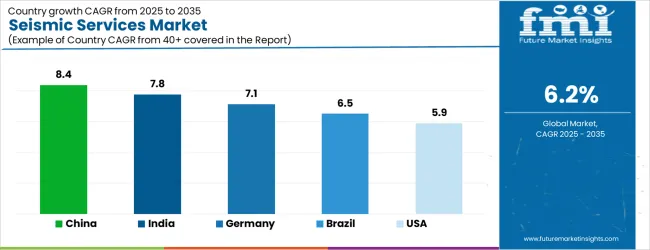
| Country | CAGR |
|---|---|
| China | 8.4% |
| India | 7.8% |
| Germany | 7.1% |
| Brazil | 6.5% |
| USA | 5.9% |
| UK | 5.3% |
| Japan | 4.7% |
The Seismic Services Market is expected to register a CAGR of 6.2% during the forecast period, exhibiting varied country level momentum. China leads with the highest CAGR of 8.4%, followed by India at 7.8%. Developed markets such as Germany, France, and the UK continue to expand steadily, while the USA is likely to grow at consistent rates. Japan posts the lowest CAGR at 4.7%, yet still underscores a broadly positive trajectory for the global Seismic Services Market. In 2024, Germany held a dominant revenue in the Western Europe market and is expected to grow with a CAGR of 7.1%. The USA Seismic Services Market is estimated to be valued at USD 3.5 billion in 2025 and is anticipated to reach a valuation of USD 3.5 billion by 2035. Sales are projected to rise at a CAGR of 0.0% over the forecast period between 2025 and 2035. While Japan and South Korea markets are estimated to be valued at USD 418.6 million and USD 232.9 million respectively in 2025.
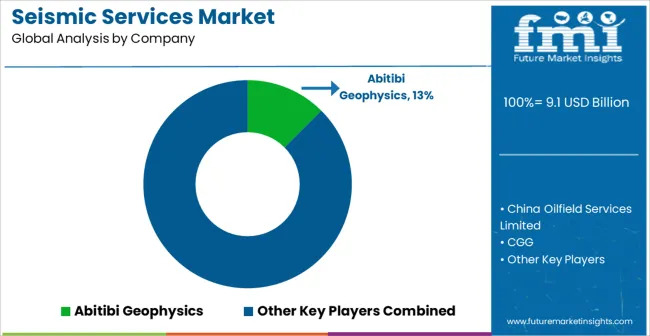
| Item | Value |
|---|---|
| Quantitative Units | USD 9.1 Billion |
| Type Of Data Acquisition | Land Seismic Acquisition, Marine Seismic Acquisition, and Transition Zone Seismic Acquisition |
| Services Offered | Data Acquisition, Data Interpretation, and Data Processing |
| Technology | 3D Imaging, 2D Imaging, and 4D Imaging |
| Regions Covered | North America, Europe, Asia-Pacific, Latin America, Middle East & Africa |
| Country Covered | United States, Canada, Germany, France, United Kingdom, China, Japan, India, Brazil, South Africa |
| Key Companies Profiled | Abitibi Geophysics, China Oilfield Services Limited, CGG, Dawson Geophysical Company, EGS (International) Ltd, Fugro, Getech Group plc, Gardline Limited, Halliburton, NUVIA Dynamics Inc., PGS, Paradigm Group B.V., Ramboll Group A/S, and SLB |
The global seismic services market is estimated to be valued at USD 9.1 billion in 2025.
The market size for the seismic services market is projected to reach USD 16.7 billion by 2035.
The seismic services market is expected to grow at a 6.2% CAGR between 2025 and 2035.
The key product types in seismic services market are land seismic acquisition, marine seismic acquisition and transition zone seismic acquisition.
In terms of services offered, data acquisition segment to command 42.7% share in the seismic services market in 2025.






Our Research Products

The "Full Research Suite" delivers actionable market intel, deep dives on markets or technologies, so clients act faster, cut risk, and unlock growth.

The Leaderboard benchmarks and ranks top vendors, classifying them as Established Leaders, Leading Challengers, or Disruptors & Challengers.

Locates where complements amplify value and substitutes erode it, forecasting net impact by horizon

We deliver granular, decision-grade intel: market sizing, 5-year forecasts, pricing, adoption, usage, revenue, and operational KPIs—plus competitor tracking, regulation, and value chains—across 60 countries broadly.

Spot the shifts before they hit your P&L. We track inflection points, adoption curves, pricing moves, and ecosystem plays to show where demand is heading, why it is changing, and what to do next across high-growth markets and disruptive tech

Real-time reads of user behavior. We track shifting priorities, perceptions of today’s and next-gen services, and provider experience, then pace how fast tech moves from trial to adoption, blending buyer, consumer, and channel inputs with social signals (#WhySwitch, #UX).

Partner with our analyst team to build a custom report designed around your business priorities. From analysing market trends to assessing competitors or crafting bespoke datasets, we tailor insights to your needs.
Supplier Intelligence
Discovery & Profiling
Capacity & Footprint
Performance & Risk
Compliance & Governance
Commercial Readiness
Who Supplies Whom
Scorecards & Shortlists
Playbooks & Docs
Category Intelligence
Definition & Scope
Demand & Use Cases
Cost Drivers
Market Structure
Supply Chain Map
Trade & Policy
Operating Norms
Deliverables
Buyer Intelligence
Account Basics
Spend & Scope
Procurement Model
Vendor Requirements
Terms & Policies
Entry Strategy
Pain Points & Triggers
Outputs
Pricing Analysis
Benchmarks
Trends
Should-Cost
Indexation
Landed Cost
Commercial Terms
Deliverables
Brand Analysis
Positioning & Value Prop
Share & Presence
Customer Evidence
Go-to-Market
Digital & Reputation
Compliance & Trust
KPIs & Gaps
Outputs
Full Research Suite comprises of:
Market outlook & trends analysis
Interviews & case studies
Strategic recommendations
Vendor profiles & capabilities analysis
5-year forecasts
8 regions and 60+ country-level data splits
Market segment data splits
12 months of continuous data updates
DELIVERED AS:
PDF EXCEL ONLINE
Seismic Survey Market Size and Share Forecast Outlook 2025 to 2035
Seismic Protection Device Market Size and Share Forecast Outlook 2025 to 2035
Seismic Reinforcement Material Market Size and Share Forecast Outlook 2025 to 2035
Seismic Sensors Market Size and Share Forecast Outlook 2025 to 2035
Seismic Monitoring Equipment Market Size and Share Forecast Outlook 2025 to 2035
Seismic Survey Equipment Market Size and Share Forecast Outlook 2025 to 2035
M2M Services Market Size and Share Forecast Outlook 2025 to 2035
B2B Services Review Platforms Market Size and Share Forecast Outlook 2025 to 2035
Bot Services Market Size and Share Forecast Outlook 2025 to 2035
Spa Services Market Size and Share Forecast Outlook 2025 to 2035
Microservices Orchestration Market Growth - Trends & Forecast 2025 to 2035
VOIP Services Market Analysis - Trends, Growth & Forecast through 2034
Global AI HR Services Market Size and Share Forecast Outlook 2025 to 2035
Legal Services Market Size and Share Forecast Outlook 2025 to 2035
Oracle Services Market Analysis – Trends & Forecast 2024-2034
AR Tour Services Market Analysis - Size and Share Forecast Outlook 2025 to 2035
Tableau Services Market Size and Share Forecast Outlook 2025 to 2035
Managed Services Market Analysis - Size, Share, and Forecast Outlook 2025 to 2035
Walk-in Services Market Growth – Trends & Forecast 2024-2034
The AI Legal Services Market Analysis - Size and Share Forecast Outlook 2025 to 2035

Thank you!
You will receive an email from our Business Development Manager. Please be sure to check your SPAM/JUNK folder too.
Chat With
MaRIA